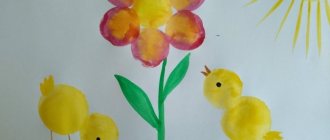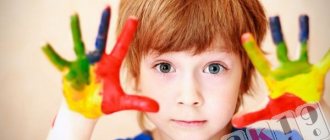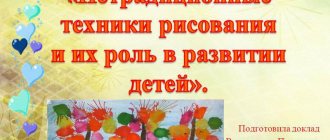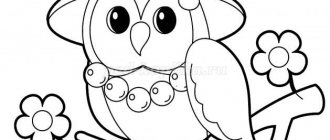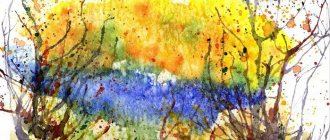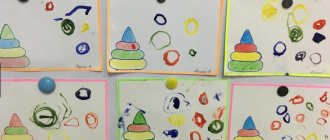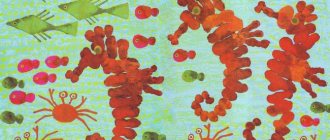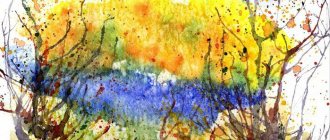Non-traditional drawing techniques: meaning and tasks in the preparatory group
Children aged seven years confidently use classical drawing techniques. Colored pencils and paints are used for the work. The techniques of folk painting are studied for their technical aspects. Classical drawing classes in the preparatory group are aimed at developing independent composition, the ability to convey movement and plot on a sheet of paper. Monotonous brush strokes and pencil shading can provoke emotional burnout in students. The desire to draw fades away.
Monotony in classes discourages the desire to draw and fantasize
Unconventional drawing techniques are the creation of an image using unusual tools/materials or alternative techniques. It is recommended to combine or alternate classical drawing classes with non-standard techniques. Children gain a sense of novelty in the creative process. The imagination is activated. The use of unexpected tools - threads, toothbrushes, straws, etc. - is experimentation for a child. Children gain new knowledge and new opportunities in non-traditional drawing classes.
Unusual materials for drawing attract children and make them want to start drawing right away
The inclusion of non-traditional drawing techniques in the educational process is carried out within the framework of the preschool education program. The importance of alternative fine art techniques is significant for the education of a well-rounded personality, as required by the Federal State Educational Standard. In the preparatory group, non-traditional techniques contribute to the fulfillment of educational tasks:
- improving fine motor skills and motor coordination of hands,
- preparing the brush for writing,
- forming an idea of the properties of certain materials through research and experimentation,
- development of imaginative and logical thinking,
- development of a sense of color and shape,
- maintaining the psycho-emotional health of children,
- stimulating imagination
- the formation of a sustainable interest in independently thinking through a plan and implementing it,
- development of aesthetic taste.
Unconventional drawing is a good mood, self-confidence and the fight against fears
Preparatory group. Senior preschool age. Children 6-7 years old
Abstract of an educational activity for drawing with children 5-6 years old “Painting a dish” based on Gorodets painting “Introducing children 5-6 years old to Gorodets painting”
.
Part 6. Compositions “Wreath”
and
“Garland”
.
Decorative drawing based on the Gorodets painting “Painting of a dish”
. Tasks. To develop children’s ability to examine products with Gorodets painting, to identify elements, traditional...
Summary of the OOD on drawing with cotton swabs “Autumn leaf fall” (preparatory group) Purpose: drawing with cotton swabs - improving creative abilities through familiarization with a new visual technique. Objectives: • mastering an unconventional way of drawing ; • improving finger motor skills and tactile perception, strengthening hand muscles; •…
List of alternative drawing techniques
By drawing in non-traditional techniques, children at the same time improve classical drawing skills:
- make a sketch with a simple pencil,
- draw details with a thin brush,
- fill the background.
The children were familiar with many techniques of unconventional drawing in previous groups. They drew accurately with fingers and cotton swabs, imprinted various patterns, and so on. The procedure for drawing using a technique known to children is not repeated in the preparatory group. The teacher shows an example of the work, the children say how it was done, and then discuss the topic of the lesson and composition options.
Older preschoolers do not need to repeat well-known techniques; let them tell and draw themselves
Let's consider alternative techniques for drawing with children 6–7 years old.
Fingergraphy
Drawing with your fingertips is often perceived as something for toddlers. Indeed, little ones love to smear paint. But this drawing technique is also suitable for older preschoolers.
Finger painting has a therapeutic effect. Touching your fingers to paper and drawing lines and dots are calming activities.
In the preparatory group, finger paints are replaced with gouache - it is cheaper and the palette is richer. And children know how to mix the colors and shades required by design.
In the preparatory group, gouache is used for fingergraphy
In the preparatory group, finger painting is carried out according to diagrams. The guys voice each stage of the scheme, prepare materials and get to work.
Albums and manuals with such diagrams can be offered to children for independent study in the art corner.
Step-by-step drawing schemes are suitable for older preschoolers to independently study fingergraphy
Photo gallery: “Hyacinths”
Drawing a flower pot: apply gouache linearly with your fingers, in strokes
Using lines we draw the stems and leaves of hyacinths
We draw hyacinth flowers with dots, you can try to make a transition from a dark shade to a light one
Fingerprinting is ready
With the children in the nursery, we decorate it with a passe-partout and decorate it with ribbons or beads (at the children’s request). The guys give these cards to their mothers on March 8th.
Drawing with palms
Children seven years old may find it uninteresting to draw with their palms alone. The ideal task for the preparatory group is to come up with a figure based on a palm print and include it in the plot composition.
Who would have thought that you could draw an angel using your palms?
A child's imagination will turn a palm and fingerprint into an animal, bird or plant.
Options for themes for drawing with palms:
- "Animals of Africa"
- "Bullfinches on a tree"
- "Cactus",
- "Mushrooms",
- "We are funny jellyfish."
If a child decides to draw a complex composition (with background fill and background), he can not print his palm, but outline it with a simple pencil. That is, make a sketch.
By combining the techniques of finger painting and palm painting, you can depict a whole plot, for example, based on the fairy tale “Under the Mushroom”
Photo gallery: “Giraffe in Africa”
Outline the palm with a simple pencil
Fill the background with watercolors
Drawing background objects
We outline, paint and complement the sketch of the palm
Let's detail the image of the giraffe. The drawing is ready
Drawing with cotton swabs
Children in the junior and middle groups drew with sticks, replacing brushes with them. When returning to this drawing technique, older preschoolers should be told about pointillism - a style of painting: when an image is made up of strokes of the same shape. A cotton swab is convenient for applying point-by-point and repeated strokes.
Video: drawing with dots (pointillism)
Photo gallery: "Rowan"
Draw a pencil sketch of a glass and rowan stems
Paint over the contours of the glass and the background with watercolors
Draw stems and leaves with green paint using a cotton swab
Dot-draw the rowan berries with a cotton swab. The drawing is ready
Drawing with cotton swabs is organically included in a classic art lesson. For example, you can paint the costumes of the heroes or draw the foliage of trees with dots. Changing the tool (brush to cotton swab) will diversify the activity and add originality to the work.
Drawing with bulk substances
In fact, children will draw classically: they will make a sketch with a pencil, and paint the background. Then they will outline the pencil outlines with PVA glue. Bulk substances - salt, colored sand or panka - are poured over the sheet. The particles are saturated with glue and harden. After a few minutes, the unnecessary salt (or other substance) is shaken off the sheet - a beautiful pattern remains on the drawing.
As a rule, landscapes (natural or cosmic) are painted using this technique.
Photo gallery: “Winter Forest”
Paint the background with gouache
Draw snowdrifts with PVA glue
We draw landscape elements with glue: trees, snowmobiles
Sprinkle salt on top of the glue
When the glue has dried, shake off excess salt.
For unconventional drawing, you can purchase a set of colored sand. This is a bright and safe product for children's creativity: quartz sand is colored with organic resins and is non-toxic.
Poke method
Children are familiar with the poke method: gouache is picked up on a dry brush with stiff bristles and applied to the drawing with vertical, sharp movements. In older groups, filling in the stencil contours with a poke is replaced by painting over the sketch. Children use the poking method in regular classes to add texture to the drawing. The poke successfully imitates animal fur, hedgehog needles or spruce branches.
Photo gallery: “Pet”
Preparing a pencil drawing: house
Gouache is applied to a dry brush
A poke draws the figure of a kitten in motion
Using a thin brush, draw the kitten’s face
Monotype
The monotype technique is based on obtaining a complete image by symmetrically imprinting part of an object or a set of objects. Previously, children used this method to draw butterflies, cockerels, and flowers. Now they have to imprint landscape elements in a wet mirror. Using the monotype technique, natural pictures are drawn when objects are reflected in water.
The monotype technique is recommended for use in preliminary work on fine art activities. Imprinting stains and stains allows you to create an original basis for future works: collages and appliqués.
Video: lesson on monotype in the preparatory group
Photo gallery: examples of works using the monotype technique
A 6-7 year old child cannot draw a full-fledged landscape; the monotype technique comes to the rescue
Watercolor prints weakly, which can be a plus when painting faded spring landscapes
Space landscapes turn out fantastic when you print and smear paint
Monotype can be used in mixed media, for example with leaf printing
Blotography
Blotography is a drawing technique using blots. The required materials are watercolors and a plastic straw (cocktail). Older preschoolers can prepare the base in advance: fill in and work out the background, and then draw with blots.
You will need a tube to blow up the watercolor drops. To get an intricate line, you need to blow the drop to the side. In order for the drop to become a fluffy spot, the tube is held directly above the drop and air is suddenly blown out at right angles to the sheet of paper - the watercolor flies to the sides.
Video: master class on blotography
Photo gallery: “Cherry blossoms”
A drop is placed on a sheet of paper
Blow through a straw onto the paint
Inflating the blot - the trunk
We put drops of paint on the tree trunk and fan the branches
Add drops of green paint
Blowing up the weed
Add drops of white paint
Add pink paint
Blowing up the drops - cherry blossoms
Drawing with wax crayons
Kids love this stuff! Wax crayons are bright and glide easily across the paper; they quickly cover the background. But you can’t get light or dark shades with wax crayons - they are always rich in color. Therefore, these crayons are not suitable for practicing classic drawing techniques. But with them you can study the property of wax - liquid repulsion.
On thick paper, children draw a picture with crayons according to the assignment. Next, the sheet is covered with watercolors - the wax drawings appear, and water-based paint does not adhere to them.
Photo gallery: “Northern Lights”
Using crayons to draw the northern lights
Covering a sheet of paper with watercolors
Using gouache we draw additional elements: iceberg and ice floes
You can also draw with a piece of simple wax candle. With children, we often start drawing winter landscapes by applying snowflakes over the entire area of the sheet with regular wax. Then the children classically fill the background with watercolors - the snowfall appears.
Spray
The spraying technique is considered easy for preschoolers to master. Apply paint (gouache or watercolor) to a damp toothbrush. With one hand the child holds a brush over a sheet of paper, in the other - a wooden skewer, pencil or ruler. With quick movements, he points the stick towards himself - splashes of paint fly onto the paper.
In the preparatory group, children use spray painting to complement the finished work: imitate raindrops, snow, falling leaves, starry skies, fireworks sparks. This technique is often used to decorate backgrounds and in blanks for appliqués and cards.
When not combined with other spray painting techniques, compositions are created using templates.
Video: drawing lessons for children (splatter)
Photo gallery: “Winter landscape”
We lay out on the sheet the elements that should remain white
Using a toothbrush and a glass, apply the first, lightest layer.
Place the second one on top of the first stencil.
Apply a second layer of paint, that is, spray with blue gouache
When the spray has dried, remove the stencils - the winter landscape is ready
Children of the seventh year of life are good at making splashes, directing the brush to the right place in the drawing. But still, the tables must first be covered with oilcloth or newspapers (it is recommended to make this a work task for children). The guys put on aprons.
Drawing on wet
In the older group, children experimented with watercolors. A sheet of paper was moistened with water using a sponge and paint was dripped onto the damp surface - amazing patterns spread out. For children 6–7 years old, the wet drawing technique involves obtaining blurry images on a wet background. If the guys don’t have time and the background dries out, then moisten the background (or its individual sections) with a sponge and clean water.
Video: drawing lesson on a wet sheet
Photo gallery: “Flowers”
The background for the work is filled with watercolors
Draw stems and leaves on a wet background using green watercolors
We draw flowers in cups, these will be tulips
The drawing is ready
Preschoolers find it difficult to paint with watercolors. The paintings are not as bright and clear as when using gouache. Unusual watercolor painting on a wet sheet or through wet gauze attracts children. Tell your children the rule for beginning artists: “To make friends with watercolor, first make friends with water!”
Batik
Batik in kindergarten is drawing on fabric. Children have a significant practical goal:
- make a handkerchief as a gift for mom,
- decorate a tablecloth for an exhibition or art corner,
- paint a T-shirt as a memory of kindergarten.
Drawing a picture on a T-shirt is a practically significant task for children
If children do not just draw on pieces of fabric, but create objects for later use, then it is necessary to prepare special paints. The use of reserve staff is at the discretion of the teacher.
In addition to painting fabric with patterns, it is worth learning the knotted batik technique with children aged 6–7 years. The canvas is tied in knots and paints are applied. When the fabric is straightened out again, interesting images are obtained, to which the children draw on the details.
Video: master class on knotted batik
Photo gallery: “Knotted batik”
Tie a knot in the center of the piece and place it on a plastic cup with the knot facing up.
Apply paint of one color on the knot, another color around the knot
Use paints of different colors to paint the scrap to your taste
Leave the handkerchiefs to dry
Straighten dry work
Scratch
Scratching, or waxography, is the creation of an image by scratching on a surface filled with ink/gouache. In the preparatory group, the teacher prepares the basics for scratching together with the children. For them, it is again an exploration: “What happens if?”
You can scratch not only the main object (bird), but also the background using the grattage technique
Workpiece option No. 1
- Paint the cardboard with wax crayons.
- Fill with black gouache or several layers of mascara.
- Leave to dry.
Workpiece option No. 2
- Paint the cardboard with spots of bright watercolor.
- Apply a continuous layer of wax (rub the cardboard with a candle).
- Cover with gouache/ink.
- Leave to dry.
To prevent the mascara from rolling off, mix it with a drop of soap solution.
Video: how to draw a grattage
Photo gallery: “Festive fireworks”
A glass skewer or wooden skewer is suitable for scratching.
Drawing a city street and houses
We depict fireworks with sparks and stars
The city landscape in an unusual technique is ready
Sets and notebooks for creating engravings are made using the grattage technique. The kit includes a scraper for removing black coating - underneath there is a smooth iridescent surface. Scratch pads are a great gift idea for children.
Stamping
Creating an image from prints (stamping) is a drawing technique familiar to children. You can print a wide variety of objects to get unusual patterns:
- dry leaves,
- Chinese cabbage,
- halves of fruits and vegetables,
- pieces of foam sponge,
- cotton pads,
- wad of paper
You can make original stamps with your own hands - from vegetables and fruits
In the preparatory group, stamping is used to add texture to landscape works and in combination with other non-traditional drawing methods.
Photo gallery: examples of work using the stamping technique
The drawing “Blooming meadow in moonlight” is supplemented with spraying and stamping techniques
Landscape “Crimean Spring” is decorated with stamping - flowering fields
Thematic drawing “Penguins” combines stamping with vegetables and foam rubber
An unusual stamp is made from cotton swabs tied into a bundle.
Ebru
The ancient technique of erbu came from Asia and involves painting with paints on the surface of water. Senior preschool age is an ideal period for getting acquainted with Ebru materials and techniques. You need to prepare for drawing:
- clear viscous liquid
Recipe for liquid for ebru: Prepare a paste from starch and hot water, cool, stir with a small amount of office glue.
- lightly dilute acrylic paints with water,
- wooden/metal sticks,
- thick paper,
- trays or convenient bowls.
Drawing on water instantly attracts children
Acrylic is dripped onto the surface of the water using sticks and created patterns and paintings. Children aged 6–7 years use the ebru technique to draw waves, concentric circles, butterflies, and flowers.
The image is transferred to a sheet dipped in water.
Video: rules of drawing using the ebru technique
Photo gallery: “Fairytale Flower”
Three colors are sprayed on the surface of the water.
Draw lines along the surface with a stick - background
Using a stick, drops of different sizes are applied to each other in the center of the composition - the base of the flower
Using a stick, circles are transformed into flower petals
Transfer the drawing to a piece of paper
Remove the drawing from the water, let it dry and add details if desired.
Erbu is an interesting and accessible technique for all ages. In our center we organize open classes for children and parents in the morning (junior groups) and master classes (senior preschoolers).
Examples of finished works
Children put their finished work on the table so that the teacher can evaluate their talent. Most often, children like to draw images on the theme “Defender of the Fatherland Day”, “March 8”, “Autumn”, “Spring has come”, “The coldest month”, “Profession”, “Forest”, “Why day follows night”, “Clothing” ", "Our kindergarten is like a home."
Works of preschoolers
The most popular theme for children is “Headdress”. The children learn to correctly name hats and their parts, telling what types they come in. For example, to come to the beach, you need to wear a Panama hat and a hat. When late autumn comes, women wear scarves and light scarves. And already in February and January you need to wear a warm pompom.
Dot drawing classes for preschoolers in kindergarten
How to make notes for a lesson on drawing in non-traditional techniques
The lesson notes indicate:
- goals and objectives,
- preliminary work (if carried out),
- materials and equipment,
- progress of the lesson.
Working on organizing the lesson is the responsibility of the teacher
According to SanPiN standards, a drawing lesson in the preparatory group lasts 25–30 minutes.
- Organizational moment - 1 minute.
- Introductory stage – 4–6 minutes.
- Practical part - 16–20 minutes.
- Display and discussion of works - 2–3 minutes.
- Reflection and summing up - 1 minute.
Between the structural elements of the lesson, didactic games and dynamic pauses are included.
Outdoor games and warm-ups are a form of health protection in drawing classes
Table: summary of a lesson on drawing in an unconventional technique, scratch paper “Dinosaur Excavation” (preparatory group)
| Author | Semenyako T. |
| Tasks |
|
| Preliminary work |
|
| Materials and equipment |
|
| Contents of the lesson | Children sit in a semicircle on chairs on the carpet. V.: Guys! Today we will meet dinosaurs again! She will be unusual. Want to go in search of dinosaurs? (Children’s answers are usually positive.) Reading the poem “Dinosaurs” by E. Aerova V.: Guys, why can’t we meet dinosaurs anywhere other than the museum? D: Because dinosaurs became extinct. They don't live now. Q: How then did dinosaurs get into the museum? Maybe they live in a museum? (Children's answers) V. gives the correct answer: Of course, dinosaurs do not live in museums. There they are kept in the form of stuffed animals, skeletons or fossils. In the museum you can find out what dinosaurs looked like, their height and weight, and coloring. Let's remember which scientists helped us learn everything about dinosaurs? How did they find them and where? (Children's answers) <…> V.: Let's imagine that on your tables there is an excavation site. Here is a “piece of earth” (shows the prepared cardboard for scratching), and tools (shows a sharp stick and a napkin). Using a sharp stick, you will “find” the dinosaur you want on a black background. But this work is not only interesting, but also difficult, and you need to prepare for it. Let's stand freely in front of the chairs and warm up. Physical education Setting an educational task V.: Guys, how to “find” a dinosaur? It’s very simple - you need to scratch it on a black background with a sharp stick. This image method is called “scratching”, or in other words, scratches. Think about what kind of dinosaur you want to find and scratch the drawing. Think about whether your dinosaur is tall or short, what kind of neck, tail, paws does it have? Are there horns, spikes or claws? You can draw a dinosaur as if it were alive, or you can draw its skeleton. Look what dinosaur I recently dug up. Next, show a sample and explain the scratching technology. Practical work for children At the end of the lesson, an exhibition is organized and the work is analyzed. V.: Well, our excavations have come to an end, and now I invite young paleontologists to tell us what they managed to find, what are the names of your dinosaurs. 2-3 children speak, and the opinions and assessments of those interested are heard. You can suggest making an illustrated magazine: “Dinosaurs”. |
| Quote from: https://www.maam.ru/detskijsad/konspekt-zanjatija-po-risovaniyu-v-netradicionoi-tehnike-gratazh-raskopki-dinozavra-podgotovitelnaja-grupa.html | |
Non-traditional drawing classes are often conducted in a playful way, for example, children go on a dinosaur dig
Dinosaur Dig is an ideal pedagogical development. The lesson is combined with topics on studying the surrounding world (“Professions”, “Animal World”), satisfies children’s desire to experiment and undoubtedly develops their imagination. The list of preliminary work includes a visit to a paleontological museum - unfortunately, they are located in only a few cities of the Russian Federation. Make a presentation and let the children visit the Museum of Antiquities virtually!
This is probably every child's dream - to become a paleontologist and dig up a dinosaur.
Long-term planning for non-traditional drawing for the preparatory group
The program on alternative drawing techniques contains:
- Explanatory note: place of the course in the educational program of the preschool educational institution,
- goals and objectives.
- consultations,
- exhibition of works,
Table: long-term plan for unconventional drawing (fragment)
| Month | Subject | Goals | Execution technique |
| October | "My hometown" |
| Students' choice |
| “Red, yellow, gold - all over the colored sheet” |
| Leaf prints | |
| November | "Birch" |
| Charcoal drawing |
| "Painted Forest" |
| Poking drawing | |
| Author | Naumova E. N., teacher of the Municipal Preschool Educational Institution “Kindergarten No. 164” | ||
| Quote from: https://www.maam.ru/detskijsad/perspektivnyi-plan-po-netradicionomu-risovaniyu-podgotovitelnaja-grupa.html | |||
Creativity is meant to bring joy to children. Let drawing in each non-traditional technique become a small but memorable game. Experiments with materials and tools, unexpected results and unbridled flights of imagination! Unusual drawing techniques expand possibilities and strengthen children's courage to express artistic talents.
